《放射治疗剂量学》课程教学资源(PPT专题讲稿)RADIATION PROTECTION IN DIAGNOSTIC AND INTERVENTIONAL RADIOLOGY L 20 - Optimization of Protection in Digital Radiology

IAEA Training Material on Radiation Protection in Diagnostic and Interventional Radiology RADIATION PROTECTION IN DIAGNOSTIC AND INTERVENTIONAL RADIOLOGY L 20:Optimization of Protection in Digital Radiology IAEA International Atomic Energy Agency
IAEA International Atomic Energy Agency RADIATION PROTECTION IN DIAGNOSTIC AND INTERVENTIONAL RADIOLOGY L 20: Optimization of Protection in Digital Radiology IAEA Training Material on Radiation Protection in Diagnostic and Interventional Radiology
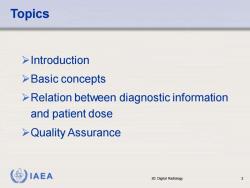
Topics >Introduction >Basic concepts >Relation between diagnostic information and patient dose >Quality Assurance IAEA 20:Digital Radiology
IAEA 20: Digital Radiology 2 Topics ➢Introduction ➢Basic concepts ➢Relation between diagnostic information and patient dose ➢Quality Assurance
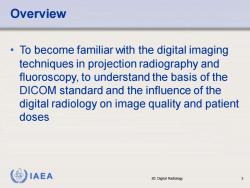
Overview To become familiar with the digital imaging techniques in projection radiography and fluoroscopy,to understand the basis of the DICOM standard and the influence of the digital radiology on image quality and patient doses IAEA 20:Digital Radiology
IAEA 20: Digital Radiology 3 Overview • To become familiar with the digital imaging techniques in projection radiography and fluoroscopy, to understand the basis of the DICOM standard and the influence of the digital radiology on image quality and patient doses
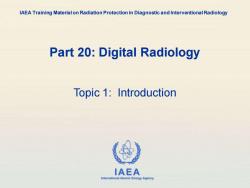
IAEA Training Material on Radiation Protection in Diagnostic and Interventional Radiology Part 20:Digital Radiology Topic 1:Introduction IAEA International Atomic Energy Agency
IAEA International Atomic Energy Agency Part 20: Digital Radiology Topic 1: Introduction IAEA Training Material on Radiation Protection in Diagnostic and Interventional Radiology
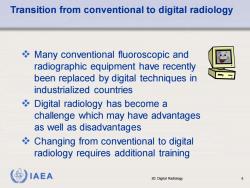
Transition from conventional to digital radiology Many conventional fluoroscopic and radiographic equipment have recently been replaced by digital techniques in industrialized countries 必 Digital radiology has become a challenge which may have advantages as well as disadvantages Changing from conventional to digital radiology requires additional training IAEA 20:Digital Radiology
IAEA 20: Digital Radiology 5 Transition from conventional to digital radiology ❖ Many conventional fluoroscopic and radiographic equipment have recently been replaced by digital techniques in industrialized countries ❖ Digital radiology has become a challenge which may have advantages as well as disadvantages ❖ Changing from conventional to digital radiology requires additional training
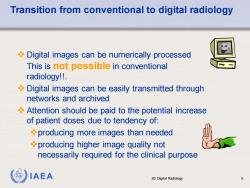
Transition from conventional to digital radiology Digital images can be numerically processed This is not possible in conventional radiology!!. Digital images can be easily transmitted through networks and archived Attention should be paid to the potential increase of patient doses due to tendency of: producing more images than needed producing higher image quality not necessarily required for the clinical purpose IAEA 20:Digital Radiology
IAEA 20: Digital Radiology 6 Transition from conventional to digital radiology ❖ Digital images can be numerically processed This is not possible in conventional radiology!!. ❖ Digital images can be easily transmitted through networks and archived ❖ Attention should be paid to the potential increase of patient doses due to tendency of: ❖producing more images than needed ❖producing higher image quality not necessarily required for the clinical purpose
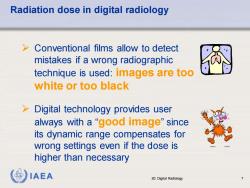
Radiation dose in digital radiology >Conventional films allow to detect mistakes if a wrong radiographic technique is used:images are too white or too black >Digital technology provides user always with a“good image”since its dynamic range compensates for wrong settings even if the dose is higher than necessary IAEA 20:Digital Radiology
IAEA 20: Digital Radiology 7 Radiation dose in digital radiology ➢ Conventional films allow to detect mistakes if a wrong radiographic technique is used: images are too white or too black ➢ Digital technology provides user always with a “good image” since its dynamic range compensates for wrong settings even if the dose is higher than necessary
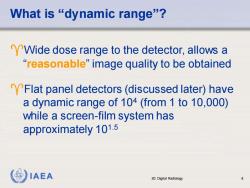
Vhat is“dynamic range”? Wide dose range to the detector,allows a "reasonable"image quality to be obtained Flat panel detectors(discussed later)have a dynamic range of 104(from 1 to 10,000) while a screen-film system has approximately 101.5 IAEA 20:Digital Radiology
IAEA 20: Digital Radiology 8 What is “dynamic range”? Wide dose range to the detector, allows a “reasonable” image quality to be obtained Flat panel detectors (discussed later) have a dynamic range of 104 (from 1 to 10,000) while a screen-film system has approximately 101.5

Characteristic curve of CR system 3.5 HR-III 3 CEA Film-Fuji Mammofine 2.5 2 品 1.5 CR response 1 0.5 0 .001 0.01 0.1 Air Kerma(mGy) IAEA 20:Digital Radiology
IAEA 20: Digital Radiology 9 Characteristic curve of CR system HR-III CEA Film-Fuji Mammofine CR response Air Kerma (mGy) 0.001 0.01 0.1 1 3.5 3 2.5 2 1.5 1 0.5 0 Density
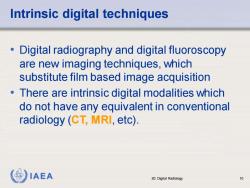
Intrinsic digital techniques 0 Digital radiography and digital fluoroscopy are new imaging techniques,which substitute film based image acquisition There are intrinsic digital modalities which do not have any equivalent in conventional radiology(CT,MRI,etc). IAEA 20:Digital Radiology 10
IAEA 20: Digital Radiology 10 Intrinsic digital techniques • Digital radiography and digital fluoroscopy are new imaging techniques, which substitute film based image acquisition • There are intrinsic digital modalities which do not have any equivalent in conventional radiology (CT, MRI, etc)
按次数下载不扣除下载券;
注册用户24小时内重复下载只扣除一次;
顺序:VIP每日次数-->可用次数-->下载券;
- 《放射治疗剂量学》课程教学资源(PPT专题讲稿)Radiation Protection Refresher Course New Concepts in Radiation Shielding for Radiotherapy Facilities.ppt
- 《放射治疗剂量学》课程教学资源(PPT专题讲稿)The Use of High-Energy Protons in Cancer Therapy.ppt
- 山东第一医科大学:《放射治疗剂量学》课程教学资源(PPT专题讲稿)放射治疗剂量学 Brife Introduction of Radiation Therapy and radiation dosimetry.ppt
- 山东第一医科大学:《放射治疗剂量学》课程教学资源(打印版)教学大纲(负责人:王鹏程).pdf
- 山东第一医科大学:《医学影像电子学》课程教学课件(打印版)第十章 逻辑代数及其化简.pdf
- 山东第一医科大学:《医学影像电子学》课程教学课件(打印版)第十四章 时序逻辑电路.pdf
- 山东第一医科大学:《医学影像电子学》课程教学课件(打印版)第十六章 AD、DA转换器.pdf
- 山东第一医科大学:《医学影像电子学》课程教学课件(打印版)第十五章 脉冲产生与整形电路.pdf
- 山东第一医科大学:《医学影像电子学》课程教学课件(打印版)第十二章 组合逻辑电路(Combinational Logic Circuit).pdf
- 山东第一医科大学:《医学影像电子学》课程教学课件(打印版)第十三章 触发器.pdf
- 山东第一医科大学:《医学影像电子学》课程教学课件(打印版)第十一章 门电路.pdf
- 山东第一医科大学:《医学影像电子学》课程教学课件(打印版)第六章 功率放大电路.pdf
- 山东第一医科大学:《医学影像电子学》课程教学课件(打印版)第八章 波形的产生与变换电路.pdf
- 山东第一医科大学:《医学影像电子学》课程教学课件(打印版)第五章 反馈放大电路.pdf
- 山东第一医科大学:《医学影像电子学》课程教学课件(打印版)第九章 直流稳压电源.pdf
- 山东第一医科大学:《医学影像电子学》课程教学课件(打印版)第七章 信号的运算与处理电路.pdf
- 山东第一医科大学:《医学影像电子学》课程教学课件(打印版)第四章 放大电路的频率响应.pdf
- 山东第一医科大学:《医学影像电子学》课程教学课件(打印版)第三章 集成运算放大器.pdf
- 山东第一医科大学:《医学影像电子学》课程教学课件(打印版)第二章 基本放大电路.pdf
- 山东第一医科大学:《医学影像电子学》课程教学课件(打印版)第一章 半导体器件基础.pdf
- 山东第一医科大学:《放射治疗剂量学》课程教学资源(PPT专题讲稿)医疗照射的辐射防护.ppt
- 《放射治疗剂量学》课程教学资源(PPT专题讲稿)头颈部放射治疗进展 Challenges in Optimal Delivery of Radiation in Head and Neck Cancers.ppt
- 《放射治疗剂量学》课程教学资源(PPT专题讲稿)医学物理工程的发展(北京大学:包尚联).ppt
- 《放射治疗剂量学》课程教学资源(PPT专题讲稿)21世纪CT技术革命 The Revolution of CT Technology(广州医学院:谢楠柱).ppt
- 《放射治疗剂量学》课程教学资源(PPT专题讲稿)关于发展我国医学物理学的思考(中国医学科学院:郑钧正).pdf
- 山东第一医科大学:《放射治疗剂量学》课程教学资源(打印版)放射治疗剂量学实验指导.pdf
- 广东医科大学:《临床生物化学及检验》课程教学资源(各章练习,含答案)第四章 酶学检测技术.pdf
- 广东医科大学:《临床生物化学及检验》课程教学资源(各章练习,含答案)第一章 绪论.pdf
- 广东医科大学:《临床生物化学及检验》课程教学资源(各章练习,含答案)第五章 自动生化分析技术.pdf
- 广东医科大学:《临床生物化学及检验》课程教学资源(各章练习,含答案)第六章 血浆蛋白质与含氮化合物的生物化学检验.pdf
- 广东医科大学:《临床生物化学及检验》课程教学资源(各章练习,含答案)第七章 糖代谢紊乱的生物化学检验.pdf
- 广东医科大学:《临床生物化学及检验》课程教学资源(各章练习,含答案)第八章 血浆脂代谢紊乱的生物化学检验.pdf
- 广东医科大学:《临床生物化学及检验》课程教学资源(各章练习,含答案)第九章 电解质与酸碱平衡的生物化学检验.pdf
- 广东医科大学:《临床生物化学及检验》课程教学资源(各章练习,含答案)第十章 微量元素与维生素异常的生物化学检验.pdf
- 广东医科大学:《临床生物化学及检验》课程教学资源(各章练习,含答案)第十一章 体液中酶的生物化学检验.pdf
- 广东医科大学:《临床生物化学及检验》课程教学资源(各章练习,含答案)第十二章 肝胆疾病的生物化学检验.pdf
- 广东医科大学:《临床生物化学及检验》课程教学资源(各章练习,含答案)第十三章 肾脏疾病的生物化学检验.pdf
- 广东医科大学:《临床生物化学及检验》课程教学资源(各章练习,含答案)第十四章 心血管系统疾病的生物化学检验.docx
- 广东医科大学:《临床生物化学及检验》课程教学资源(各章练习,含答案)第十五章 骨代谢紊乱和相关元素的的生物化学检验.pdf
- 广东医科大学:《临床生物化学及检验》课程教学资源(各章练习,含答案)第十六章 内分泌疾病的生物化学检验.pdf
